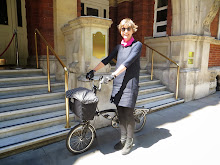If you are thinking of cycling on the road it may well
be worth contacting your local authority/ council who often provide free cycle
training which will give you some really good pointers for cycling on
the road.
Whether you are cycling to friends or with friends, on your own or commuting to work, planning the route makes things much easier. This will help you to identify places to stop for refreshments, follow train stations if you think you might need the option not to cycle home and will be especially beneficial to help you find roads that are less busy without fast moving traffic. If you are near NCN an (National Cycling Networks) they can be good routes to follow although their signposting can be intermittent so a map will help if there is a problem.
Google maps, Transport for London (if you are cycling in London), and Sustrans all provide maps. Organisations like British Cycling and Cycling Touring Club (CTC) also offer guidance and knowledge along with cycling insurance.
Going for a ride with friends, ie social cycling, is not the same as leading a ride where you would have a responsibility to the group you are leading. This would require appropriate insurance, a route that has been researched and tested, possibly a support team and definitely a real understanding of group riding. CTC, Sustrans and British Cycling can offer advice on leading a ride as it is not something to be taken lightly.
Finding people in your area who are putting together social rides where the pace is conversational rather than painfully pacey is a good thing to do, once you can do at least 10 miles in an hour on mainly flat roads. I was introduced to cyclechat which has a friendly group of cycling enthusiasts as opposed to experts and elitists. Obviously, as with all websites, dont just rush in to meet people on your own but I have met and made some very good friends and cycling buddies through cyclechat.
If you are worried about your fitness, start small and
build upwards. A mile on day one, two miles on day two,
three miles on day three all the way to 10 miles on day 10 then five
miles on day 11 and no miles on day 12 then 10 miles on day 14. After
that as many as you like as often as you can.
Eating
food as fuel will make a big difference. Porridge for breakfast is
really good, pasta with olive oil and ham and/or cheese the night
before. Unsalted peanuts and raisins are really good once you are on
your ride - a handful (about six peanuts and 20 raisins after an hour) or a small piece of flapjack. Scarily it is really easy to eat more calories than you are burning but you do need to fuel your body for the exercise. Carbohydrates and protein are crucial.
A lunchstop of fish or chicken or beef with some carbs a
baked potato. It is worth noting that unfortunately eating more calories than you burn is not as healthy as
it could be!
Equally if not more important is hydration which
is crucial regardless of the weather. Sip some water after 45 minutes
and then every 20 minutes or so thereafter. A headache on the forehead
is often a sign of dehydration. Caffeine in coffee is dehydrating and
worth avoiding. If you are tired it can give you a burst of energy but that soon burns off leaving you dehydrated. Very occasionally I will have a decaffeinated coffee. Dried fruit and nuts are much better as you really feel a sugar rush which spurs you on! Water is the best hydration that compliments the fruit and nuts.
Drinking water after each ride and doing some basic stretches will really help too. Each stretch should be for at least 20 seconds if not 30. Any stretch less than 20 seconds doesnt achieve anything.
Drinking water after each ride and doing some basic stretches will really help too. Each stretch should be for at least 20 seconds if not 30. Any stretch less than 20 seconds doesnt achieve anything.











No comments:
Post a Comment